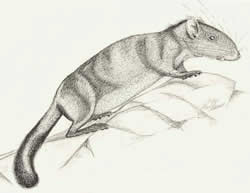A weird species of rodent, totally new to science, has been discovered on sale in a southeast Asian food market. The rock rat - or kha-nyou as it is known in Laos - is unlike any rodent seen before by scientists.
"It was for sale on a table next to some vegetables," says conservation biologist Robert Timmins, "And I knew immediately it was something I had never seen before." People in the Khammouan region of Laos know of the species, and prepare it by roasting it on a skewer, says Timmins, of the Wildlife Conservation Society, based in New York City, US.
Timmins and his team have subsequently trapped the animal with the help of local people, but have never seen it alive either in the wild or in the market. Relatively little is yet known of how it lives or the full extent of its habitats.
The creature looks something like a cross between a large dark rat and a squirrel, but is actually more closely related to guinea pigs and chinchillas. The long-whiskered rodent has a thick, furry tail, large paws, stubby limbs and is around 40 centimetres from nose to tail. Initial evidence suggests it gives birth to a single young at a time. The discovery was reported in the journal Systematics and Biodiversity.
What makes Laonastes aenigmamus so unusual is that it is not closely related to any other rodents. The researchers behind the find have had to create a whole new family, the Laonastidae, to accommodate it.
Rare delicacy
Although new rodents are discovered by scientists at the rate of about one a year, new mammal families are much rarer, Timmins told New Scientist. The last new mammal family was created in 1974 with the discovery of the bumblebee bat. "To find something so distinct in this day and age is just extraordinary," he says.
The species may be the primitive ancestor to a large group of mostly African and South American rodents known as the Hystricognathi. This group includes mole rats, guinea pigs, capybaras, porcupines and chinchillas. Laonastes may have diverged from these species tens of millions of years ago, Timmins says. Today its closest living relatives are found in Africa.
"The discovery is particularly interesting because it may throw new light on theories about the evolution and past distribution of Old and New World rodents," says rodent expert and study co-author Paulina Jenkins of the Natural History Museum in London, UK.
The researchers have too little information on the population size and distribution of Laonastes to currently confirm whether or not it is an endangered species, says Jenkins. However, evidence suggests its habitat is confined to rocky limestone outcrops in and around the protected Khammouan National Biodiversity Conservation Area, and is therefore not likely to be very widespread.
Journal reference: Systematics and Biodiversity (DOI: 10.1017/S1477200004001549)
If you would like to reuse any content from New Scientist, either in print or online, please contact the syndication department first for permission. New Scientist does not own rights to photos, but there are a variety of licensing options available for use of articles and graphics we own the copyright to.
Have your say
Only subscribers may leave comments on this article. Please log in.
This comment breached our terms of use and has been removed.
All comments should respect the New Scientist House Rules. If you think a particular comment breaks these rules then please use the "Report" link in that comment to report it to us.
If you are having a technical problem posting a comment, please contact technical support.






